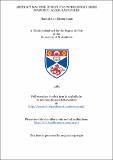Files in this item
Abstract machine design for increasingly more powerful ALGOL-languages
Item metadata
| dc.contributor.advisor | Morrison, Ronald | |
| dc.contributor.author | Gunn, Hamish Iain Elston | |
| dc.coverage.spatial | 216 p. | en_US |
| dc.date.accessioned | 2018-05-22T13:40:42Z | |
| dc.date.available | 2018-05-22T13:40:42Z | |
| dc.date.issued | 1985 | |
| dc.identifier.uri | https://hdl.handle.net/10023/13461 | |
| dc.description.abstract | This thesis presents the work and results of an investigation into language implementation. Some work on language design has also been undertaken. Three languages have been implemented which may be described as members of the Algol family with features and constructs typical of that family. These include block structure, nested routines, variables, and dynamic allocation of data structures such as vectors and user-defined structures. The underlying technique behind these Implementations has been that of abstract machine modelling. For each language an abstract intermediate code has been designed. Unlike other such codes we have raised the level of abstraction so that the code lies closer to the language than that of the real machine on which the language may be implemented. Each successive language is more powerful than the previous by the addition of constructs which were felt to be useful. These were routines as assignable values, dynamically initialised constant locations, types as assignable values and lists. The three languages were, Algol R a "typical" Algol based on Algol W h an Algol with routines as assignable values, enumerated types, restriction of pointers to sets of user-defined structures, and constant locations. nsl a polymorphic Algol with types as assignable values, routines as assignable values, lists, and type- and value-constant locations. The intermediate code for Algol R was based on an existing abstract machine. The code level was raised and designed so that it should be used as the input to a code generator. Such a code generator was written improving a technique called simulated evaluation. The language h was designed and a recursive descent compiler written for it which produced an intermediate code similar in level to the previous one. Again a simulated evaluation code generator was written, this time generating code for an interpreted abstract machine which implemented routines as assignable and storable values. Finally the language nsl was designed. The compiler for it produced code for an orthogonal, very high level tagged architecture abstract machine which was implemented by interpretation. This machine implemented polymorphism, assignable routine values and type- and value- constancy. Descriptions of the intermediate codes/abstract machines are given in appendices. | en_US |
| dc.language.iso | en | en_US |
| dc.publisher | University of St Andrews | |
| dc.subject.lcc | QA76.8A6G8 | |
| dc.subject.lcsh | Electronic data processing | En |
| dc.title | Abstract machine design for increasingly more powerful ALGOL-languages | en_US |
| dc.type | Thesis | en_US |
| dc.type.qualificationlevel | Doctoral | en_US |
| dc.type.qualificationname | PhD Doctor of Philosophy | en_US |
| dc.publisher.institution | The University of St Andrews | en_US |
This item appears in the following Collection(s)
Items in the St Andrews Research Repository are protected by copyright, with all rights reserved, unless otherwise indicated.

